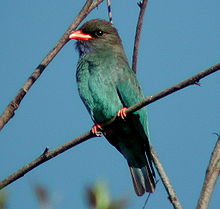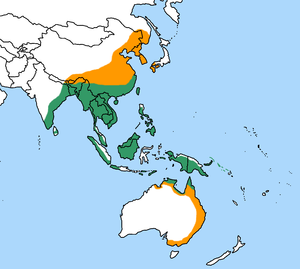Turquoise jacket
| Turquoise jacket | ||||||||||
|---|---|---|---|---|---|---|---|---|---|---|

Turquoise pad ( Eurystomus orientalis ) |
||||||||||
| Systematics | ||||||||||
|
||||||||||
| Scientific name | ||||||||||
| Eurystomus orientalis | ||||||||||
| ( Linnaeus , 1766) |
The turquoise hackle ( Eurystomus orientalis ), also called the dollar bird based on the English name , is a Southeast Asian and Australasian scapular species . The name dollar bird of the robust, large-headed bird is derived from a shiny silver badge in the middle of the outer hand wings, which is reminiscent of a silver dollar. At least nine subspecies have been described, some of which differ significantly in terms of plumage color, beak size and shape, and overall size.
Appearance
The turquoise rag is a stocky bird about 25-28 centimeters in total length. The largest subspecies ( E. o. Solomonensis ) that occurs on the Solomon Islands and Bougainville grows up to 34 centimeters. The bird looks stocky, stocky. It has a large head and a very short neck. The tail and legs are also very short. Basic color of the perching bird is a dark, iridescent green, depending on the incident light in different greens, purples and browns oscillate can. The top is iridescent greenish-blue, the underside more gray-green. The arm and hand wings are bright dark blue. The throat and front chest are bluish purple.
The wing field from which it is named is formed by often silvery shimmering, light blue feather sections of the hand wings. It is relatively inconspicuous as an elongated, light wing field in the seated bird. The head is black or dark brown, the eyes are dark; sometimes a fine, light or reddish eye ring can be seen. The red beak is relatively short but very broad; it ends in a fine, dark hook. The bird is very noticeable in flight: the broad, not very long wings, which are clearly bent in the wrist, are bright dark purple except for the coverts of the upper and lower wings. The above-mentioned badge is visible on the upper and lower side of the outer hand wings, which varies greatly in size, color and clarity between the subspecies. The sexes hardly differ from each other, young birds are pale in color, their beak is gray on the upper side and yellow-orange on the lower side.
voice
Turquoise racks are acoustically not very noticeable outside of courtship time. The most common call is a rough, croaking chääk that is repeated several times and varied in various ways . Accelerating series of calls, for example kräk - käk - käk, are heard less frequently . Paired turquoise skirts, sitting next to each other, make very quiet sounds reminiscent of castanets . Voice example
distribution and habitat
The turquoise rag is distributed in at least 9 subspecies from southwest India , the eastern Himalayan region and Sri Lanka across the entire Southeast Asia north to Korea , Manchuria , the Ussuri region and southern Japan. The islands south of Japan are also populated. It also occurs in the Andaman Islands , the Philippines and most of the large and small Sunda Islands except for Sulawesi , where the rocket birds are represented by the Celebes hack ( Coracias temminckii ). In the Eastern Pacific, the species has colonized many islands in Melanesia , such as the Bismarck Archipelago and the Solomon Islands, almost all of New Guinea and the north, west and southwest of Australia. In Australia, New Guinea, China, and Japan, it is the only type of rocket.
In this large distribution area, which extends in the north to 50 ° north and in the south to 40 ° south, the turquoise rock inhabits different habitats. In the more southerly distribution areas, these are secondary forests and the more marginal regions of rainforests, or clearings in the rainforest with individual tall trees, coffee and rubber plantations and gallery forests along rainforest rivers. In the north it can be found in the loosened woodland, on the edges of agricultural land, and occasionally in the tree-steppe. In Australia in particular, it has also invaded the vicinity of human settlements and breeds in orchards and in large parks.
hikes
Most of the tropical populations are resident birds. Birds of the northern range, such as the Manchurian and Japanese birds, leave their breeding grounds in early to mid-September and overwinter in Southeast Asia, particularly in Malaysia . They return to their breeding grounds in early April. Except for a few resident birds in the tropical northern regions, the Australian turquoise racks are also migratory birds; they mostly move over the Torres Strait to New Guinea and the Lesser Sunda Islands ; some already overwinter in northern Australia. The departure of Australian birds begins at the end of February, and by mid-September most of them have re-occupied their breeding grounds. In their entire range, the adult birds leave the breeding areas before the young birds; they form smaller migration groups and migrate at relatively great heights during the day. Occasionally, turquoise skirts appear in New Zealand .
Turquoise racks are particularly common in the lowlands and hill country areas up to 600 meters above sea level . In the foothills of the Himalayas they are found up to heights of 1000 meters, in East Asia and New Guinea the highest known breeding sites are at heights of 1500 meters.
Food and subsistence
Turquoise racks primarily prey on flying insects. Beetles are the main food, but crickets , grasshoppers , cicadas and fishing horrors are also consumed. Bugs , moths and termites play a rather subordinate role. The species uses different hunting strategies; the most effective is probably a relatively fast, hawk-like hunting flight, which is mainly practiced in the late afternoon and early twilight hours. Often a number of birds gather to hunt together. In addition, insects flying past are also preyed on by waiting areas such as trees standing alone or telephone lines. On the ground you see dollar birds hunting less often. In addition to their insect food, they also prey on small mammals , amphibians and reptiles . Turquoise racks evidently regularly consume small stones in order to be able to grind the hard chitin shells of individual food animals; other materials, such as glass and small pieces of porcelain, and clam shells, often found in nesting burrows of dollar birds, could serve this purpose. ( Gastroliths )
Breeding biology
Turquoise skirts lead at least a monogamous breeding season marriage, but many couples remain mated for years. During the breeding season they are strictly territorial. The male's courtship is acoustically noticeable and impresses above all with remarkable courtship flights over the breeding area, in which spectacular flight acrobatics are embedded. Like all rocket birds, turquoise racks are also cave or half-cave breeders, who obtain abandoned caves from woodpeckers or bearded birds or breed in natural half-caves. These are often found at great heights in dead or living trees. Nesting material is not entered, the cave is hardly adapted in any other way. The clutch that is incubated by both parents consists of 3 to 4 eggs; the incubation period varies between 17 and 21 days; During the nestling period, which lasts about a month, the chicks are provided with food by both parents. After flying out, the young birds remain in their parent territory for a certain period of time before they migrate on a large scale .
The breeding mines are widely spread according to the large breeding area: In the northern distribution areas they are between the end of March and May, in southern India between September and May. Most of New Guinea's turquoise rags breed between October and February, those of Sumatra mainly in March. The breeding seasons in the Australian range are between October and January.
Existence and endangerment
According to the IUCN , the total population of the turquoise rock is not endangered in its large distribution area. Population figures and precise assessments of the population trend are largely lacking. Subspecies and regional populations sometimes show very negative population developments. They particularly suffer from the deforestation of the tropical rainforest and other human interference in their habitat; The increasing input of biocides in agriculturally used areas also has a negative effect on stocks. The subspecies E. o. Irisi , which occurs in small populations in southern Sri Lanka, was considered extinct for a long time, was rediscovered in 1979 and has since been identified several times.
literature
- C. Hillary Fry and Kathie Fry: Kingfishers, Bee-Eaters & Rollers . Princeton University Press, Princeton, New Yersey 1999. p. 104 and 305-308 ISBN 0-691-04879-7
swell
- ↑ Tuning game on birdsinbackyards.net (MP3; 220 kB)
- ↑ [H. Nakamura; T. Tabata (1988) Japanese Journal of Ornithology [JAP. J. ORNITHOL.]. Vol. 36, no. 4, pp. 137-152. 1988.]
Web links
- Avibase record dollar bird ( Eurystomus orientalis ) (Linnaeus, 1766)
- Eurystomus orientalis in the endangered Red List species the IUCN 2008. Posted by: BirdLife International, 2008. Accessed on December 22 of 2008.
- Videos, photos and sound recordings for Eurystomus orientalis in the Internet Bird Collection

